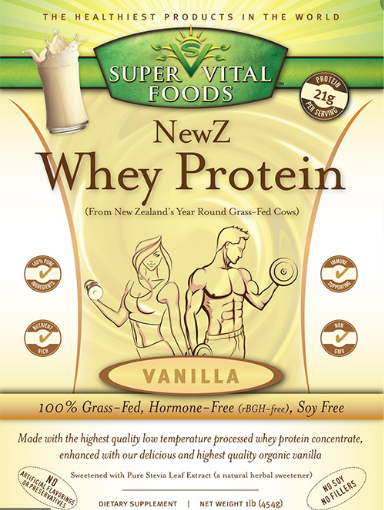Understanding the 3 Different Whey Protein Types
Many people are confused and even misinformed about the different types of whey protein in the market today. To clarify this confusion, we’ll explain here the difference between the three types and will also begin to address the quality and processing that goes into whey proteins, which are details of huge significance!
WHERE DOES WHEY PROTEIN COME FROM & HOW IS IT MADE?
It all starts at the dairy farm where cows are milked. The milk is then transported to a manufacturing facility to begin the process of cheese making. Special enzymes are added to the milk to create the separation of curds and the liquid whey. The liquid whey is then usually pasteurized, filtered, and dried into a powder to create whey protein.
WHAT ARE THE 3 DIFFERENT TYPES OF WHEY PROTEINS?
There are three forms of whey protein: Whey protein concentrate, whey protein isolate, and hydrolyzed whey protein.
Whey Protein Concentrate is the least processed form of whey protein that usually contains anywhere from 30%-85% whey protein, with varying amounts of fat and carbohydrates in the form of lactose, along with various protein sub fractions that have important biological activity which offer great health benefits. Whey protein concentrate is the most nourishing, unadulterated, and whole-food form of the whey proteins.
Whey Protein Isolate begins as a whey protein concentrate but goes through further processing to concentrate the whey to yield a higher percentage of protein, approximately 90%. This 90% whey protein isolate has less fat and carbohydrates and no protein subtractions and the associated health benefits. Whey protein isolate is the more processed and denatured form of whey protein, and is less nourishing and typically more pro-inflammatory.
Hydrolyzed Whey Protein goes through an even more extensive processing technique called "pre-digestion process." This process uses special enzymes to break peptides down into smaller units to help your body absorb and assimilate the protein faster. The issues here are that the micro fractions are completely destroyed and the absorption of the proteins is actually not significantly better than the more nourishing, complete whey protein concentrate.
We believe that whey protein concentrate is the most nutrient-rich and least processed out of the three.
Quality & Processing
of Whey Protein
IMPORTANCE OF QUALITY
Aside from understanding the difference between the three whey protein types, you must also understand that the quality and processing are CRITICAL issues to consider before deciding to purchase a whey protein product.
The most nourishing source of whey protein comes from cow milk that's 100% grass-fed, hormone-free, antibiotic-free, and soy-free. Most whey protein on the market today comes from very unhealthy, conventional milk sources from cows living in incredibly unnatural, unhealthy environments. This low quality "dirty" milk source will not result in a high-quality end product, no matter what the product label says. It’s important to note that there are an increasing number of “grass-fed” proteins on the market, but this could simply mean it has access to eating grass a few days a year. Thus, a truly healthy whey protein should be sourced from 100% grass-fed cows.
IMPORTANCE OF PROCESSING
The processing whey undergoes is PARAMOUNT, as this makes all the difference between a healthy vs detrimental end product. Whey protein, since it is a dairy product, legally has to be "pasteurized" in order to be sold in the United States (and most countries). Though raw whey protein cannot be sold, it can be processed in a way that maintains the integrity of the protein structures and associated nutrients.
The processing of whey should be done gently, using a low temperature process, or, a flash-heat process. Most whey protein products on the market are processed by exposing it to high temperatures for a prolonged period of time. This method completely destroys the associated nutrients, and also denatures (changes) the protein structures, making them more harmful to health.
DO NOT purchase any whey protein that goes through an Ion Exchange process, this is a chemical and high heat processing method that denatures the whey protein completely.
If the whey protein you are considering using or are currently using does not state anything about the process they use, then assume it is a Ion Exchange process, as this is the most common method with most conventional brands.
WHAT ABOUT SENSITIVITIES TO WHEY?
Your whey protein concentrate should come from a source that has its protein structures intact and contains all of the natural nutritional co-factors. Your body REQUIRES these nutritional co-factors to be had with the protein, to help the body properly digest, assimilate, and be nourished by the food.
Most people who have allergies or sensitivities to whey is largely, if not in some cases completely, due to the poor sourcing and processing of the whey protein they’re using. The high heat and pressure changes the protein structures, which is what causes sensitivities and allergies. When this detrimental processing is NOT done to the whey, more often then not, the individual will not experience negative symptoms.
WHAT IS THE BEST WHEY PROTEIN I CAN BUY?
At Super Vital Foods we took great care to source and produce our whey protein concentrate from only the ABSOLUTE BEST that there is. Our protein is:
100% grass-fed
Nutrient dense
Free of pesticides
Antibiotic-free
Hormone-free (rBGH-free)
Free range
Non-GMO
Gluten-free
Soy-free
Made with NO chemicals, fillers, preservatives, or artificial ingredients
Low temperature processed to preserve all of the natural constituents
If you’re ready to build a healthier, stronger body more efficiently, then give our NewZ Whey Protein Concentrates a try…we’d love to hear the difference you experience when consuming the BEST WHEY ON EARTH!
http://www.supervitalfoods.com/whey-proteins/


